NORTH WALES COAST RAILWAY:NOTICE
BOARD
Rheilffordd arfordir gogledd Cymru: Hysbysfwrdd
17 February 2014
 Last issue
Last issue Archive
Archive Share this issue
Tweet
Tweets by @NWrail1
Contributions and comments are encouraged: see the Contributions Page
This site is dedicated to all our regular contributors and supporters, and especially the rail staff of North Wales.
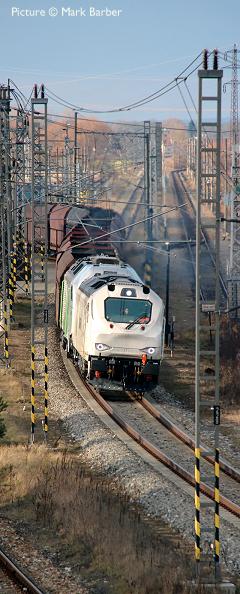
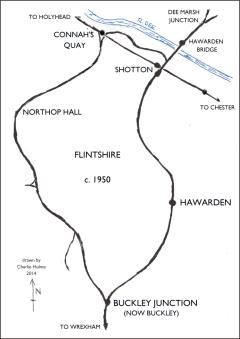
This list may be out of date if you are reading an archived page. For the current list visit our Calendar.
February 2014
Thursday 20 February Locomotive Club of Great Britain John Sloane "BR Scenes from the 60s”
Wednesday 26 February. Ffestiniog Railway Society. Dave Booth "Isle of Man Transport - Trains, Boats etc."
Thursday 27 February Merseyside Railway History Group Allan Lewis 'Union Pacific Steam'
March 2014
Tuesday 4 March North Wales Railway Circle Ken Robinson shows 'Chester to Holyhead including Llandudno branch' slides.
Friday 7 March Clwyd Railway Circle The Committee & David Southern AGM followed by the talk 'Railways of the Wirral' After the formality is over, we can look forward to Dave sharing his railway experiences of 60 years living on the Wirral.
Monday 10 March Wrexham Railway Society. Geoff Morris- Railways of New Zealand a digital presentation based on two steam-hauled trips around New Zealand in 2011 & 2012 including both preservation activities and the rapidly-changing current railway scene on the other side of the world.
Tuesday 11 March 8E Railway Asssociation Paul Shackcloth – Locomotives of the L&YR-Part 1.
Thursday 13 March Llandudno and Conwy Valley Railway Society 'The Dinorwic Quarry Railway & its locomotives' Eric Lander
Monday 17 March RCTS Merseyside, Chester & North Wales ‘The Ugly Duckling’: Bob Casselden looks at the transformation of B.R.’s ‘Other Provincial Services’ via ‘Regional Railways’ into today’s privatised railways
Friday 14 March Altrincham Electric Preservation Society A Selection of Doug Darby's UK PHOTOGRAPHS by Paul Shackcloth (Photographic Officer, Manchester Locomotive Society)
Thursday 23 January Locomotive Club of Great Britain Neville Bond “From Sea to Shining Sea” 30 years of North American scenes
Thursday 20 March Locomotive Club of Great Britain Dr Michael Bailey "The Manchester Ship Canal Railway"
Wednesday 26 March. Ffestiniog Railway Society. Group AGM followed by Adrian Gray. "Ffestiniog Heritage".
Thursday 27 March Merseyside Railway History Group AGM & Members Slides
April 2014
Friday 4 April Clwyd Railway Circle Ron Watson-Jones 'The Irish Mail Train Crash at Penmaenmawr Aug 1950' Ron’s account of the accident on 27th August 1950.
Tuesday 1 April North Wales Railway Circle Dave Rapson of Connah`s Quay presents a pictorial record of The Bidston - Wrexham Line.
Tuesday 8 April 8E Railway Asssociation Chris Banks – Engine Sheds Pt. 3 Consett to Eastbourne.
Thursday 10 April Llandudno and Conwy Valley Railway Society 'Welsh Wanderings in the 1980’s & 90’s' Geoff Morris
Thursday 10 April Merseyside Railway History Group Ted Lloyd 'Quiz and informal evening'
Friday 11 April Altrincham Electric Preservation Society Slides from the Manchester locomotive society collection by David Young. Mainly steam locomotives taken 1950s and 1960s
Monday 14 April Wrexham Railway Society. Jon Penn. Railway Pictures From the 1960’s – scanned black and white negatives and vintage colour slides, favouring the Cheshire and surrounding areas.
Saturday 26 April Excursion Chester Model Railway Club / FR Dee and Mersey: 'Somerset Coast Express' Hooton, Bache, Wrexham, Gobowen and Shrewsbury to Bristol, Weston-super-Mare, Taunton and Minehead.
Monday 28 April RCTS Merseyside, Chester & North Wales ‘South of the Border steam in the 50s and 60s’ by David Kelso, David travels from Kent to present a follow up to his earlier North of the border presentation, including a period when he was resident in the West Riding of Yorkshire.
Thursday 17 April Locomotive Club of Great Britain Norman Matthews "Steam in Central America"
May 2014
Friday 2 May (Change of date) Mid-Cheshire Rail Users' Association Excursion from Chester and stations on the mid-Cheshire line to Dumfries, Kilmarnock and Ayr.
Tuesday 6 May North Wales Railway Circle A.G.M. followed by Members Videos, Prints, Slides, and Digital work in the Photo Competition.
Thursday 8 May Llandudno and Conwy Valley Railway Society 'The Deganwy Dock Story' Eric Smith
Tuesday 13 May 8E Railway Asssociation Les Nixon - Railways of Scotland.
Thursday 15 May Locomotive Club of Great Britain AGM and Members/Visitors Slides & Digital Photos.
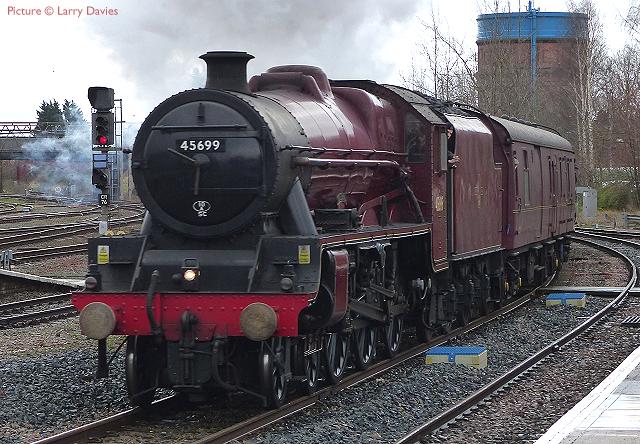
45699 Galatea passes Chester with a West Coast Railway Company excursion, 15 February. See reports below. Picture by Larry Davies.
Note: the last issues suffered from some editorial 'issues', including the disappearance of an excellent article by John Hobbs for part of the week (now restored) and a caption blunder for Mark Barber's picture of 68 002, which was in fact at the rear of the train being hauled by a Class 47. Apologies for these problems, which needless to say were nothing to do with the contributors. - Charlie
Galatea on 'The Welsh Borders'
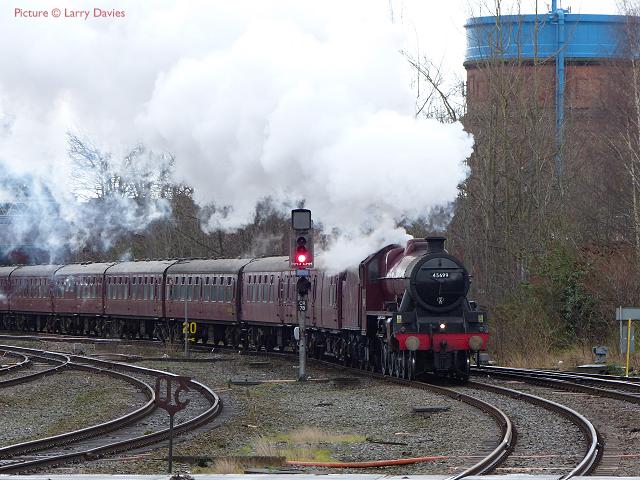
The West Coast Railway Company's excursion 'The Welsh Borders' on 15 February started from St Neots, on the East Coast Main Line in Cambridgeshire, at 05:44, and made its way, hauled by a diesel locomotive, via Doncaster, Wakefield Kirkgate, Marsden, Manchester Victoria and Warrington Bank Quay to Crewe where 'Jubilee' class steam loco 45699 Galatea took over for a run via Chester to Shrewsbury. We pick up the train approaching Chester station, ran non-stop through the non-platform line. Picture by Larry Davies.
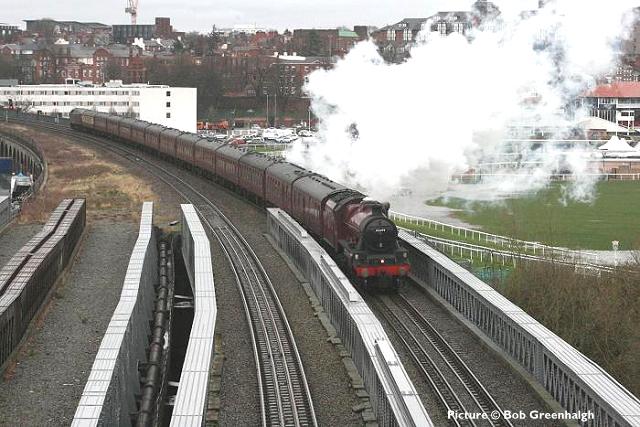
Heading out of Chester towards Wrexham over the river Dee bridge at 11:44, photographed by Bob Greenhalgh.
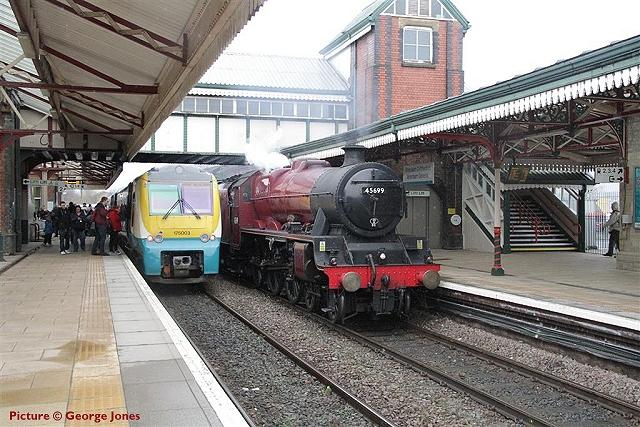
George Jones was at Wrexham General, where the train was due at 12:07 which would have allowed for the 12:02 Holyhead departure to clear the station and wait for the single line. Despite being reported 5 minutes late, the charter made good time up Gresford Bank and was given an yellow for the line south at 12:02, just as the north bound Holyhead service appeared. It could have been an unfortunate clash for photo purposes with both trains approaching the station, but in the end the two trains passing allowed for an interesting contrast of the old and the new (175 003) at Wrexham General.
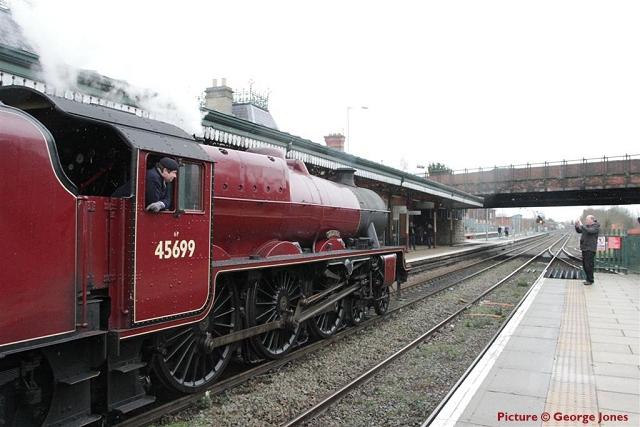
45699 drifts through platform 1 (George Jones). We understand that the British Railways-style maroon livery. never carried by this class, will be replaced in due course by the British Railways green which many people remember.
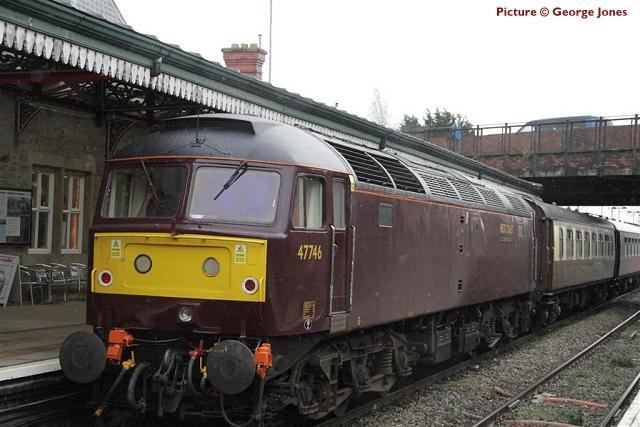
Pulling away with 47746 on the back, keeping the road users waiting at the Watery Road level crossing (George Jones).
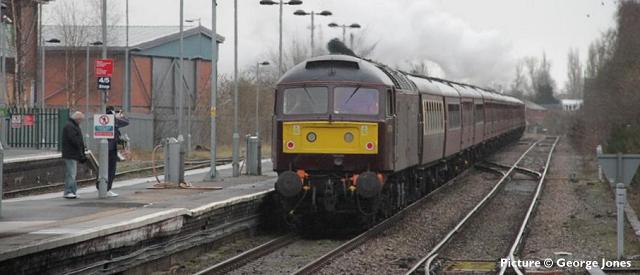
Passengers on board were no doubt agog at the sight of The General station in its former GWR glory ... and wondering about the sights of modern day Wrexham's urban environment. (George Jones).
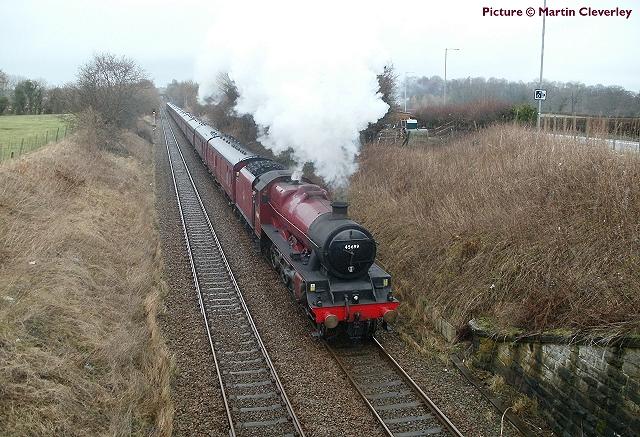
The view from a 'very wet, windy and cold' road bridge at Rhostyllen south of Wrexham (Martin Cleverley).
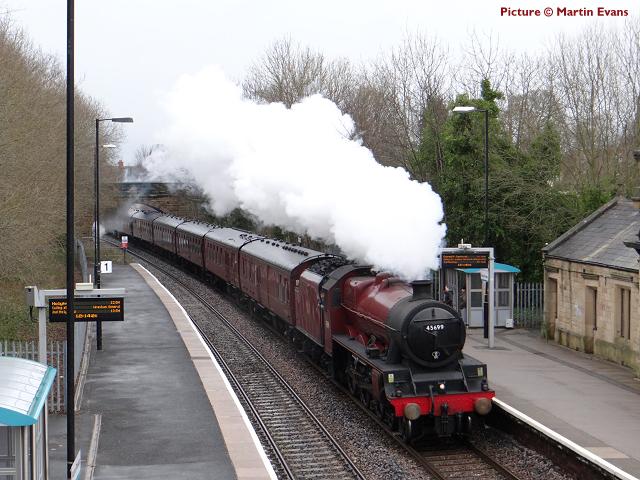
Ruabon (Martin Evans). Cold, damp weather ensures good steam effects.
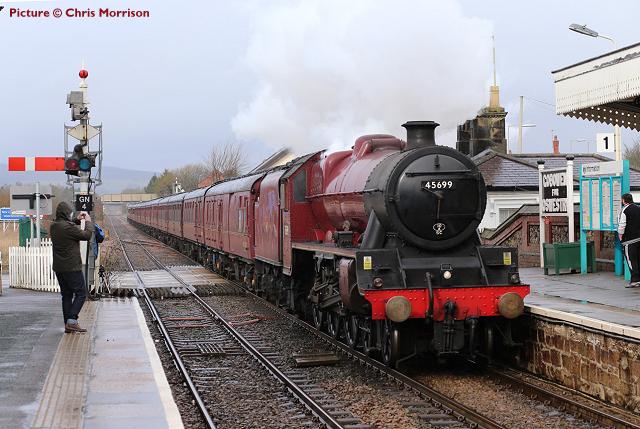
With 13 coaches and 47 746 in tow, Galatea passes Gobowen (Chris Morrison).
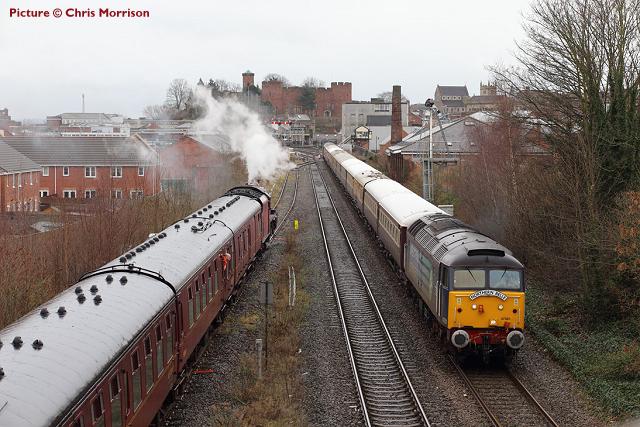
45699 reverses the empty stock of the charter at Coton Hill, Shrewsbury as DRS loco 47 501 Craftsman heads for Chester with a circular 'Northern Belle' trip from Coventry (Chris Morrison).
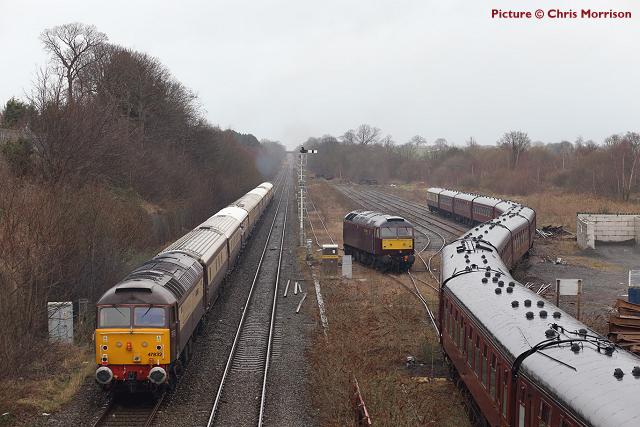
DRS loco 47 832 was on the rear of the Northern Belle while 47 746 stands in Coton Hill Yard, Shrewsbury, with the charter stock (Chris Morrison).
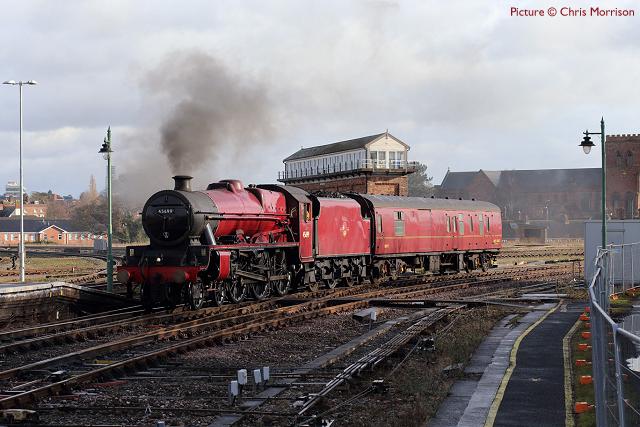
Having turned on the Abbey Foregate triangle, 45699 with its support coach heads back into Shrewsbury station with Severn Bridge Junction signal box behind (Chris Morrison).
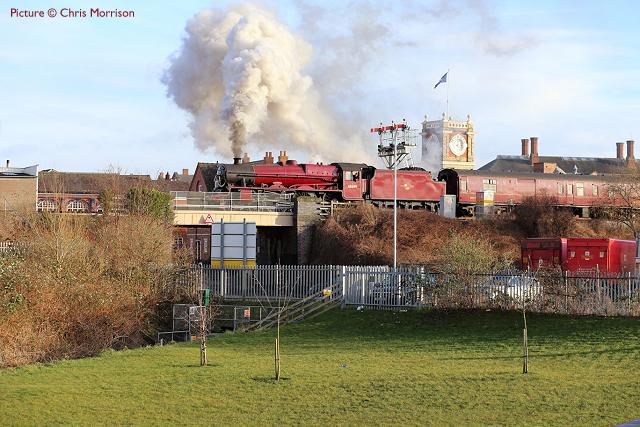
The Jubilee starts up Crewe Bank with the 16:03 return charter to St Neots and Stevenage (Chris Morrison).
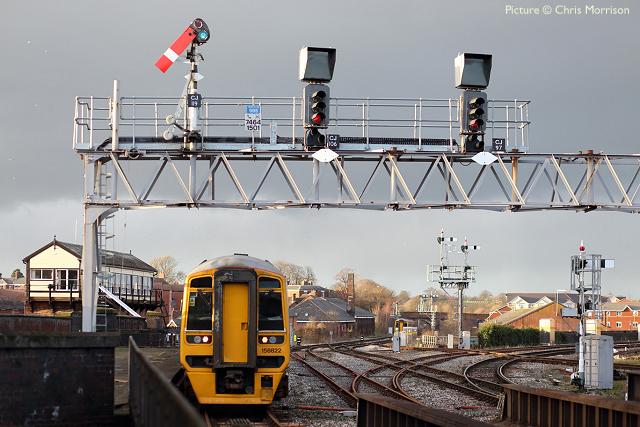
The impressive array of semaphores, and Crewe Junction signalbox at the north end of the station, with 158 832 passing (Chris Morrison).
Past Times with John Hobbs - Steam on the Irish Mail
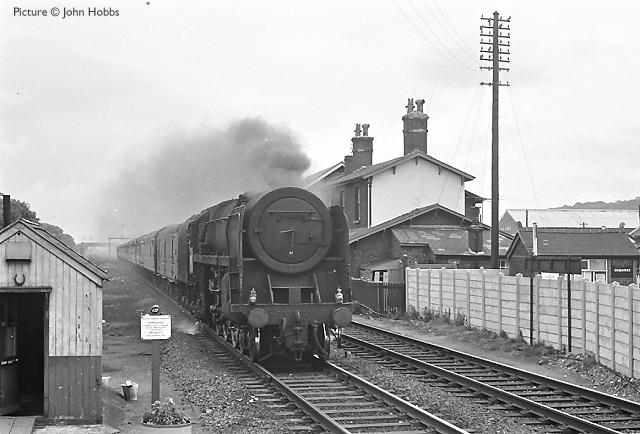
On one of those rare days, when Crewe North must have been very, very, short of Diesel Traction and by luck, I just happened to be there, train 1D41 'The Irish Mail'. 08:00 London (Euston) to Holyhead which worked to 'D475 diesel timings just happened to produce steam; it's Tuesday the 27 July 1965. The locomotive is 70046 (formerly ANZAC), also by chance one of the original Holyhead 'Britannias.' Sadly the nameplate and front number plate have been removed but she is 'motoring' along through Prestatyn, as can be seen by the vacuum created behind the smoke box which is drawing the smoke slightly forward. The train was on time and swept through the station on the 'down fast' line in fine style. The van at the front confirms its status, conveying luggage for Dublin.
Sadly I was to young to photograph the 'Irish Mail' in the heyday of 'Royal Scots' and then Britannias but I remember seeing 70048 with that enormous nameplate The Territorial Army 1908-1958 not long after it was fitted. What luck to see the Irish Mail behind steam and with one of those five Holyhead Britannias in charge as well; on the railway there is nearly always another one after the last one but being there to see it is just luck!
RAIB and the trolley 'mishap'
The Rail Accident Investigation Board has published an initial report on what it calls a 'serious near-miss' which occurred on the Crewe - Shrewsbury line on 16 January when the last passenger train of the day, the 22:36 from Manchester to Shrewsbury, struck a trolley on the line.
The site of the incident was Bridgeway user-worked crossing, between Yorton station and the closed Harlescott Crossing signalbox. A welding crew, dispatched to repair a weld fault which had been noticed in the track, were using the crossing as an access point, and the 'down' (northbound) line had been blocked for the purpose by agreement with the staff at Cardiff signalling centre which now controls the signalling here. The trolley, of the small hand-pushed folding variety, had been placed on the 'up' line to carry the welding equipment, when the Class 175 working southbound train 1J76 appeared, travelling at 85 mph, and ran in to the trolley as one of the welders jumped for his life, narrowly missing the van from which his colleague was unloading the equipment.
The train did not derail, and came to a stand in half a mile; the train driver's feelings are not hard to imagine. The RAIB states that its investigation will 'establish the sequence of events, examine how the work was planned, how the staff involved were being managed and the way in which railway safety rules were applied. It will also seek to understand the actions of the track workers involved, and factors that may have influenced their behaviour and attitudes.' Let's hope they report soon before another such incident occurs with more tragic results. It's tempting to speculate whether last year's transfer of the signalling control from local signalboxes to the remote centre played any part in events, but we must await the final Report. The line at this point is actually signalled to allow trains to run in either direction on each line, but this facility was not being used at the time of the incident.
The return of 37 422 - report by Roger Carvell
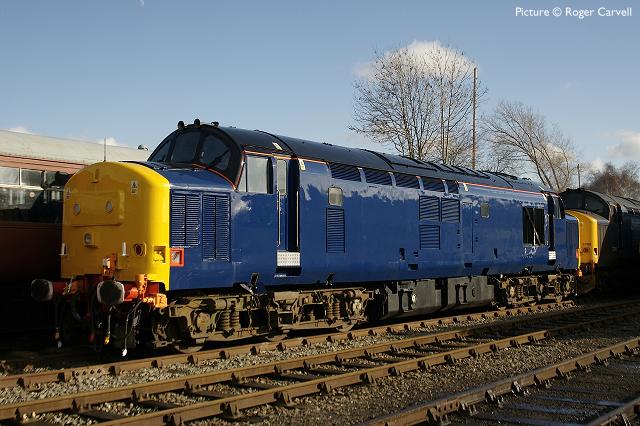
I went to Barrow Hill on Friday, 7 February 7 and was pleased to see one locomotive there with strong North Wales Coast connections. Class 37 No.37 422 is pictured, sparkling in fresh paint and only requiring the finishing touches from the vinyl operatives - I hesitate to say signwriters or painters these days.
From the records of 37 422's earlier life (with thanks to www.c37lg.co.uk), I learn that this locomotive was delivered new to the Eastern Region of BR at Darnall (Sheffield) on February 13, 1965, as D6966. Later renumbered 3 7266, it was first recorded between Chester and Holyhead in January 1986, and at the time newly converted to twin-tank status and renumbered 37 422 at Crewe Works. Much passenger work followed in Scotland before gravitating to Crewe on transfer. It began regular passenger train haulage between Crewe and Holyhead on 27 March 1993. On 3 May 3 that year it was named Robert F. Fairlie Locomotive Engineer 1831-1885'. It worked 'The Anglesey Odyssey II' from York to Amlwch and Llandudno with Pathfinder Tours on 9 October 1993.
Its last known 'coast run' was on 19 May 19,1999, from Holyhead to Chester. After a lengthy period on Valleys passenger workings in South Wales, where it was renamed Cardiff Canton. 37 422 finally ended up in store at Toton in August 2011. Now it is set for a new lease of life with DRS, while sister locomotive 37 261 (behind in the photograph) appears to be going for disposal.
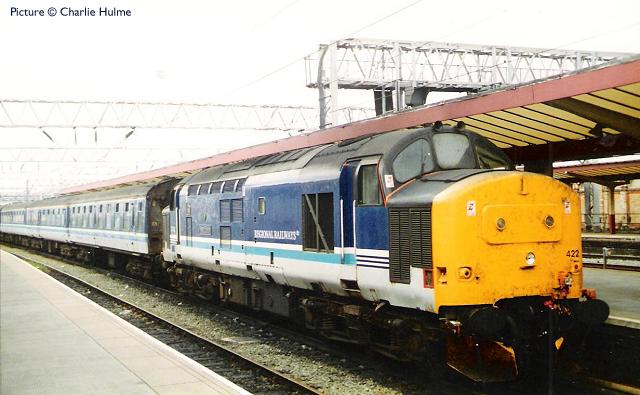
From the nwrail archive, the once-familiar scene from the mid-1990s of 37 422 having arrived in Platform 9 at Crewe with a train from North Wales. The coaches are all in matching Regional Railways livery, Mk2 vehicles except for one Mk1 behind the loco and behind that a Mk2 brake compartment first. 422 has been be uncoupled, and another 37, which has waited in the 'loco neck' outside the station after bringing in an earlier service, will take the train out again to the Coast.
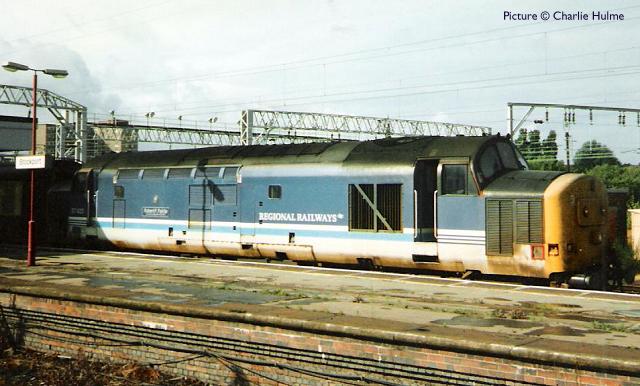
A Saturday morning scene at Stockport. 37 422 has brought the empty train from Chester via Northwich and will pick up passengers from Stockport, becoming the 'Irish Mancunian' to Holyhead via Manchester Piccadilly.
A day out to Shrewsbury - with Richard Putley
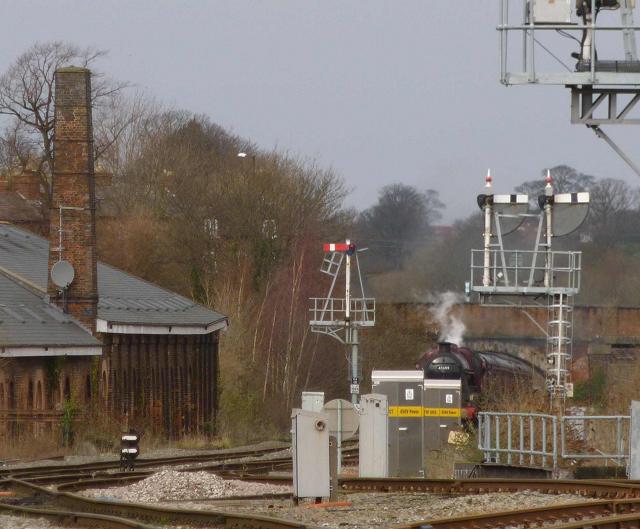
On 15 February I travelled to Shrewsbury to see 'The Welsh Borders' charter (see report above). The special had been booked to arrive at 13:00; a good run however meant that it got to Shrewsbury at 12:45. It then had to wait (picture above) at signal CJ2 (see diagram of Shrewsbury on my brother Adrian's the Rock's site) until both the delayed 12:45 to Manchester Piccadilly had departed from Platform 4 ...
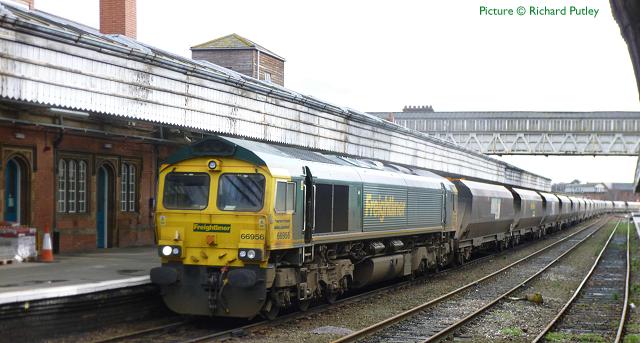
... followed by a Portbury Docks (near Bristol) to Fiddlers Ferry Power station coal train, hauled by 66 956, which also, unusually, ran through Platform 4.
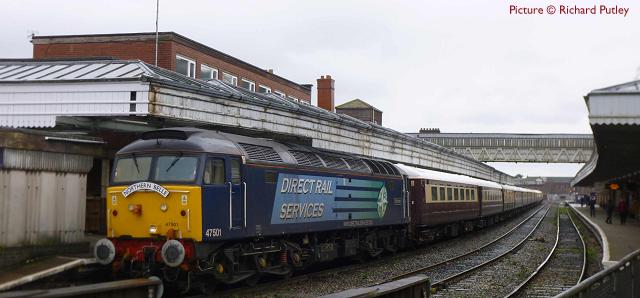
Once the passengers had alighted 47 746 hauled the train into Coton Hill sidings. No sooner had it done so than the Northern Belle Dining Train arrived from Coventry, topped and tailed by 47 501 and 47 832 . It was held until a late running train to Holyhead had reached the next signalbox, before following it down the Wrexham line.

No sooner had it gone than a ballast train hauled by a pair of Class 97/3 diesel locos appeared on the Abbey Foregate Curve, arriving from the Wolverhampton direction. It was held on the Down Loop at English Bridge Junction until the 14:05 from Shrewsbury to Swansea (via the Heart of Wales Line through Llandrindod Wells) had passed Sutton Bridge, then it headed for the Cambrian line.

Meanwhile Galatea and its support coach had uncoupled from the charter train and headed through the station on the Up Main Line to Abbey Foregate Junction. Here it waited until the ballast train had gone. then it propelled the support round the Abbey Foregate curve so as to turn round for the return journey. Galatea and support coach returned to Coton Hill and coupled on to the other end of the charter train, 47 746 having run round.
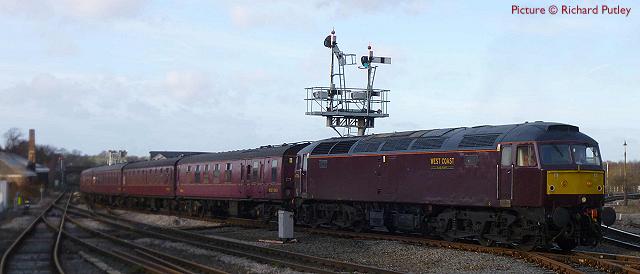
At about 15:45 47 746 drew the charter train into Platform 7 from where Galatea made a rousing start on time at 16:03, returning to Crewe via Whitchurch.
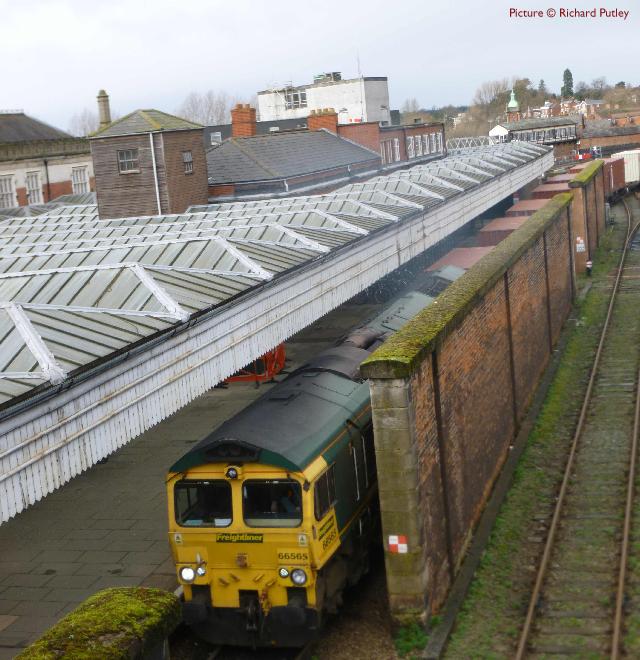
In addition to all of the above I also saw a southbound container train from Crewe Basford Hall to Wentloog (Cardiff) head through Shrewsbury at about 12:30 hauled by 66 565. So a very good day out all in all; the weather stayed dry most of the time.
Franchise debate online
The Enterprise and Business Committee's report on the Future of the Wales and Borders Rail Franchise will be debated in the Welsh Assembly on Wednesday 19 February starting at 13:30 (link to agenda).
You can watch the debate online at www.senedd.tv, or you can attend in person. Details on how you can book a place for the debate, which will be held in the Senedd in Cardiff Bay, can be found here.
Here is a link to the Welsh Government's response (singed by Edwina Hart) to the Enterprise and Business Committee's report on the Future of the Wales and Borders Rail Franchise. The gist of most of the responses is 'Don't blame us, we are not the franchise authority, but we are hoping to persuade the UK Government to devolve this to us so we can do it so much better.'
68 001 on test - report by Mark Barber
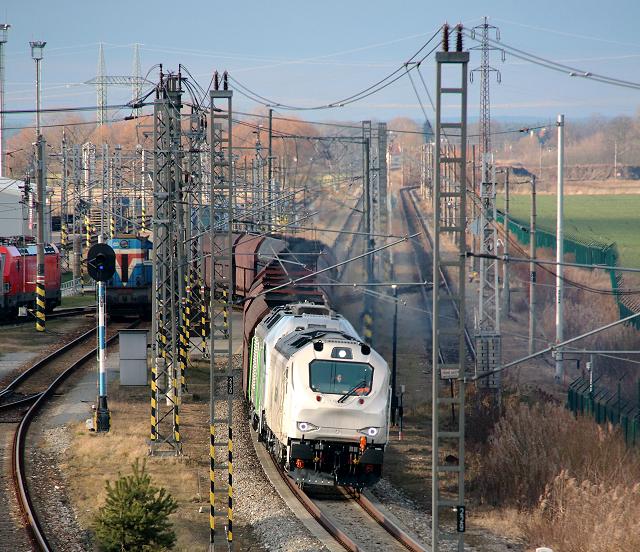
On 11 February I visited the Velim Test Track at Cerhenice, Czech Republic, on 11 February, to get some pictures of new Spanish-built loco 68 001, destined for DRS in the UK.
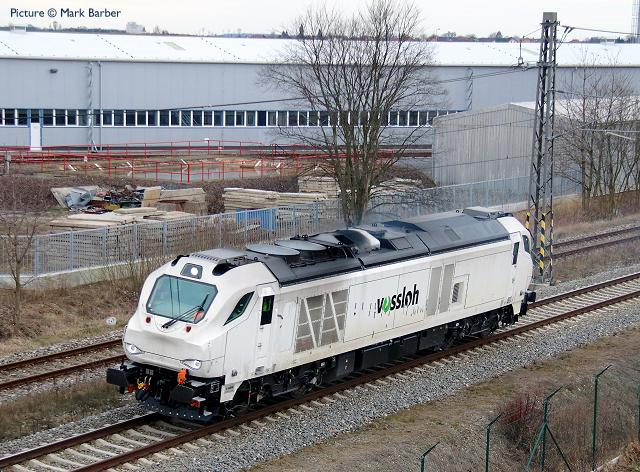
A portrait of Britain's latest diesel type.
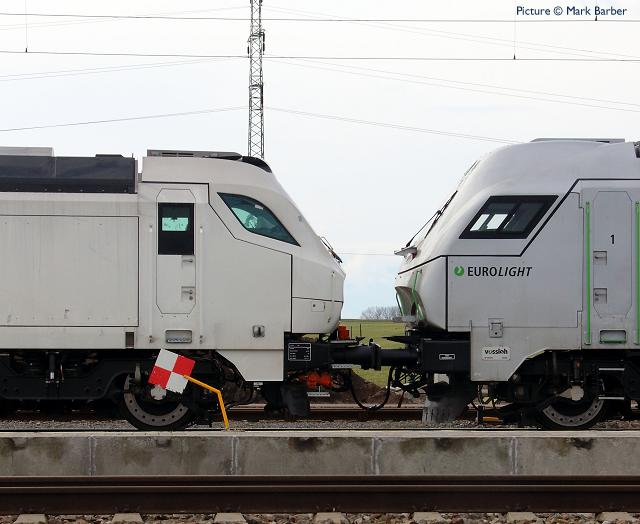
Little & Large: 68 001 next to standard European gauge 'Eurolight' sister 284 001 (UIC number 92 80 1284 001-5 D-VE)
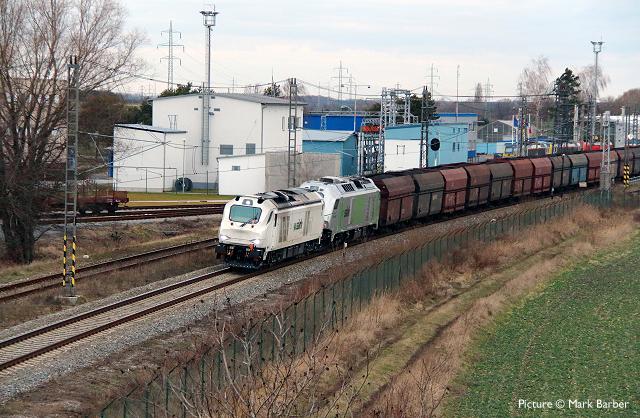
When I arrived on site, a new Italian unit was doing test runs. People where looking around 68 001, so I decided to wait. It finally moved after four hours, once the Italian had finished. 68 001 and 284 001 are seen above hauling 20 loaded bogie coal wagons.
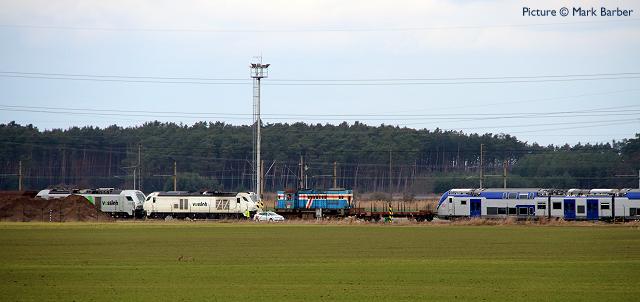
German, British, Czech & French traction (left to right) in the yard at Cerhenice. Also on site another French unit (same type), an Italian Pendolino, two Belgium locos and one German loco visible.
I have also uploaded camera phone and iPad video to my SmugMug site. The only problem was the wind.
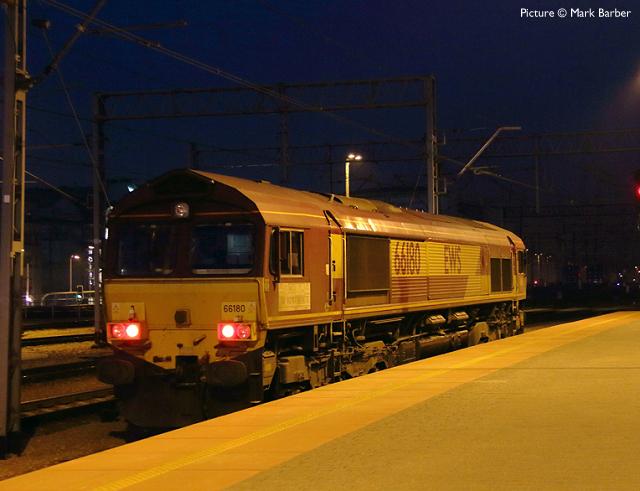
A few days later, 17 February, and a loco which has travelled from Britain: 66 180 (92 70 0066 180-5 GB) at Katowice, Poland.
Miscellany
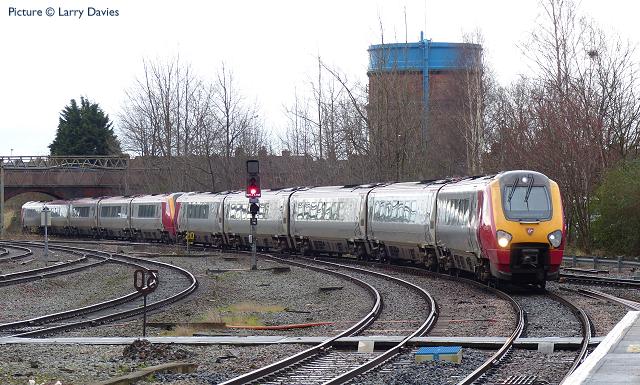
Chester on 15 February (above) with a ten-coach Virgin Voyager arriving as the 09:10 London - Holyhead (Larry Davies).
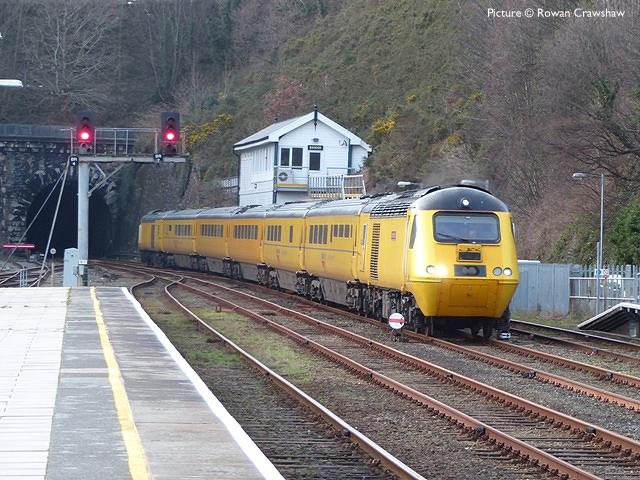
The New Measurement Train at Bangor, 13 February (Rowan Crawshaw).
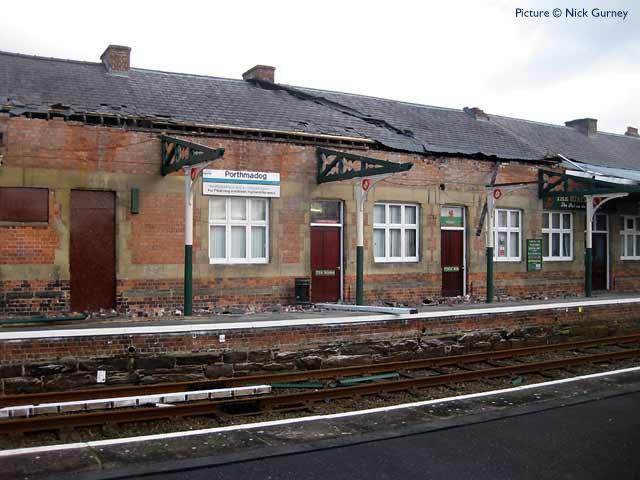
Storm damage at Porthmadog station, 13 February (Nick Gurney).
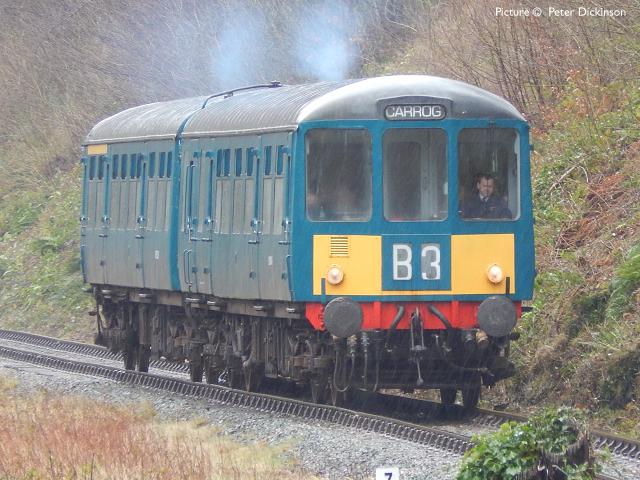
The Llangollen Railway's Class 104 'Birmingham' unit near Berwyn on the 13:00 Llangollen - Carrog, 15 February (Peter Dickinson).
Stormy Wednesday - report by Peter Basterfield
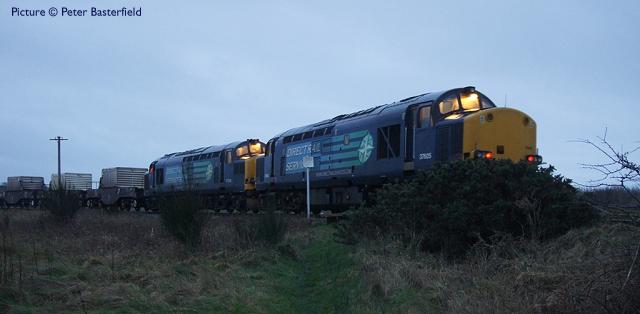
37 259 and 37 605 back their incoming flask train into the transshipment siding at Valley in the early morning gloom, on Wednesday 12 February (Peter Basterfield).
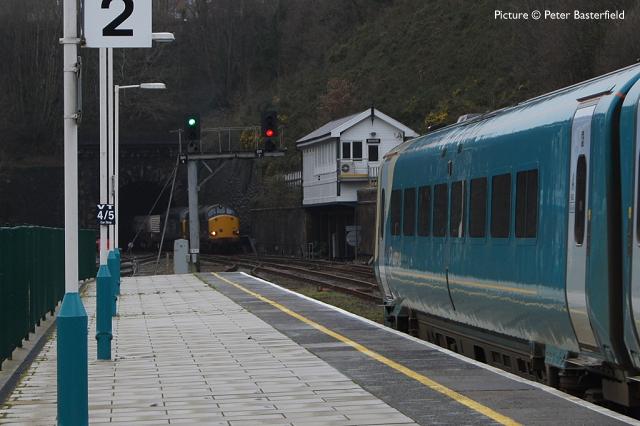
12 February saw a ban on trains across Anglesey between 14:00 and 20:00 due to storm force winds; the flask train had to return early, and are pictured at Bangor signalbox, held until the train 1H39 - 13: 31 to Manchester had cleared the section (Peter Basterfield). Despite being shown as cancelled on the indicator board, westbound Cardiff - Holyhead train 1W92, seen in the picture, left 4 minutes late and ran to Holyhead.
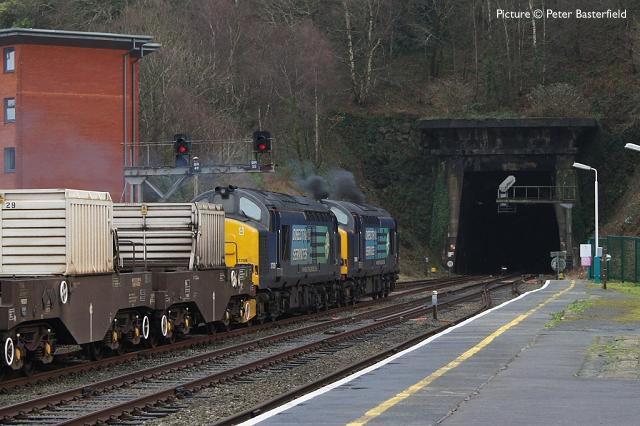
The flask train then crawled up to the up main signal and moved off 119 minutes early. The next passenger train to actually reach Holyhead was an Arriva one which should have been the 19:24 Shrewsbury - Holyhead but in fact was started from Rhyl at 22:30, called at Bangor at 23:20 and reached Holyhead at 00:10. The 17:10 Virgin service from London, which left London on time, was heavily delayed throughout and left Bangor 222 minutes late, arriving Holyhead at 00:57 instead of 20:58.
The Storm of 1936
Recent events on the Cambrian coast are not entirely unprecedented. From The Times, 11 January 1936:
(With thanks to the Ffestiniog Railway Yahoo Group.)RAILWAY TRACK SWEPT AWAY
The seas which pounded the Cardigan coast are stated to have been the worst since the great storm of 1927. A breach was made in the sea wall at Aberystwyth big enough to hold two houses. All communication along the coast southwards was cut off. At Portmadoc the sea flooded wharves and overflowed the banks of the inner harbour. Houses were flooded and part of the roof of the Britannia Foundry was blown off. The Festiniog Railway permanent way was cluttered with stones and masonry. At Penrhyndeudraeth the Great Western Railway Station was flooded, the stationmaster and his family having to take refuge in the upper storeys, and between Penrhyn, Talsarnau, and Harlech the railway track was torn up and in parts swept away for stretches totalling two miles.
All road traffic between Barmouth and Dolgelly was suspended, there being 6ft. of water on the road.
A Cambrian Coast memory - by Stephen Hughes
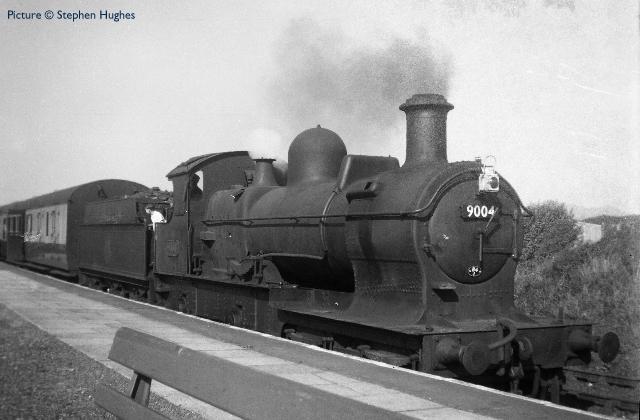
There is nothing at all to see at Pwllheli at the moment, even a 158 might be interesting, but here is a reminder of a locomotive that was one of the mainstays on the Cambrian Coast for over twenty years. 'Dukedog' 4-4-0 9004 of 84J - Croes Newydd - has arrived at Pwllheli on our train from Afon Wen, where we had changed from Caernarfon, on Wednesday 10 September 1958. One of my older brothers has unsurprisingly found his way onto the footplate and is looking back towards the train. Sadly, I have no recollection of this scene, too young as I was, although I was probably crying at the time, worried that the train would carry him away.
These locomotives, constructed in 1936 from the frames of 'Bulldog' class and the boiler from a 'Duke', were ideally suited to both freight and passenger work on the Cambrian. During the late 1950's they were superseded by more modern types and were withdrawn, 9004 - one of the last survivors - held on until June 1960. One of the class - 9017 - was preserved upon withdrawal from Oswestry in October 1960 and found its way to the Bluebell Railway. It is currently 'out of ticket', but overs of railway authenticity would hope that one day a way could be found for it to return to the Cambrian Coast, although that is probably a forlorn hope, although it did visit North Wales in 2009 as a guest of the Llangollen Railway.
The Buckley Railway - notes by Barrie Hughes
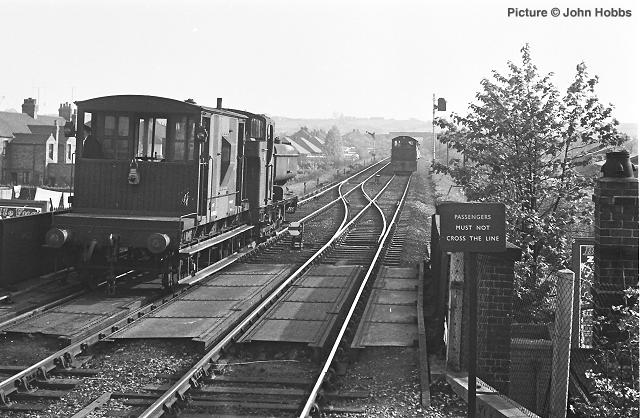
I was interested in John Hobbs' recent item on Shotton and the remains of the Buckley Railway (3 February issue). about the Buckley Railway, as I lived within a mile of the Buckley Railway from Xmas 1964 until September 1969 and then on and off until August 1975 as a student/teacher.
John's caption to the picture of Shotton High Level (repeated above) dated 12 May 1965 read:
It is interesting to reflect that the original Wrexham, Mold & Connahs Quay line closed to freight on 3 May 1965; so just what is D2218 doing; it is possible that there was inwards traffic on that date and that there would therefore be a subsequent journey to remove empty vehicles. The line is reported to have shut from Buckley Junction to Castle Fire Brick (therefore Northop Hall) from 5 July 1965. I surmise that this working with D2218 was to clear the remaining vehicles from the line; this could therefore be the last train from Northop Hall to Dee Marsh Sidings. Does anyone know more or could shed further light on this?I can confirm that in 1961 trains were only running to Northop Hall coal yard and the track down the steep Connah’s Quay incline to the docks was out of use at that time and overgrown. Coal wagons were stored in the sidings that paralleled the A494 between the Buckley Railway and Pinfold Lane level crossing. A MSLR/GC lattice signal protected the crossing at Pinfold Lane just alongside the Castle Brickworks. The white gates, the only ones on the route, had cast Great Central lamps on them.
Steam was in use in 1961 but was replaced by (Class 03?) diesel around 1963 as I recollect one came around the corner at Etna Brickworks, whilst I was cycling along the trackside footpath with friends.
The Ashton’s Branch to Shone’s Brickworks was out of use in 1961, in fact the Shone family had three (?) steam lorries (Sentinels?) parked on the trackbed at their site. The concrete gate posts still survive for the crossing of Drury/Old Buckley station, which had a station building and platform at this time although long since closed when the WMCQ service, which terminated there, was diverted to the Hawarden Loop from the 1889. I saw the ex-Buckley Railway/GCR loco shed at Drury and a shunting capstan in the early 60s before the line was lifted.
The trackbed collapsed at Ashton’s Branch Junction following the thaw of early 1964, with the northerly rail suspended by more than a foot, and I do not believe the railway was restored beyond that point, being worked entirely from Buckley Junction after this time. J.I.C. Boyd had a collection of photos from February 1965, one of which shows wagons in store at Old Buckley station/Drury and another Pinfold Lane signal published in his Oakwood Press book The Wrexham, Mold & Connah's Quay Railway, including the Buckley Railway.
By 1966 the bridge over Liverpool Road had gone and the track lifted except for the pointwork in the Ewloe Barn brickworks. Vic Mitchell and Keith Smith’s Country Railway Routes Wrexham to New Brighton shows an undated view of an 03 shunting the Connah’s Quay docks, presumably in the early sixties. This is likely to be the Crump’s Wagon Works shunter, though they provided their own in later years.
At school at Queensferry, Deeside Senior High (Now John Summer’s High School) I walked the docks trackbeds around 1967-9 and they appeared to be disused except for access to Crumps Wagon Works. I also walked the overgrown Connah’s Quay incline to Northop Hall around 1967 which was difficult as sleeper indents were still present. The road bridge across the B5126 had gone and housing estates were being constructed on the trackbed north of that point. The trackbed adjacent to Hawarden Bridge Junction between the Docks Lines and the Wrexham-Bidston line was hot due to a long lasting subterranean fire, presumably the trackbed had been built using coal shale. Not much remains of the Buckley Branch now.
I’m thinking of launching a website about it to give with my Welsh Highland Railway site when I have time. Any contributions welcome.
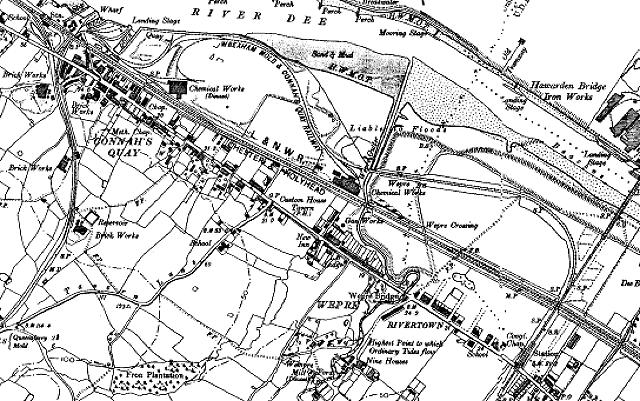
This 1900 map shows what existed at Connah's Quay at that date.
North Wales Coast home page | Archive | Previous Notice Board